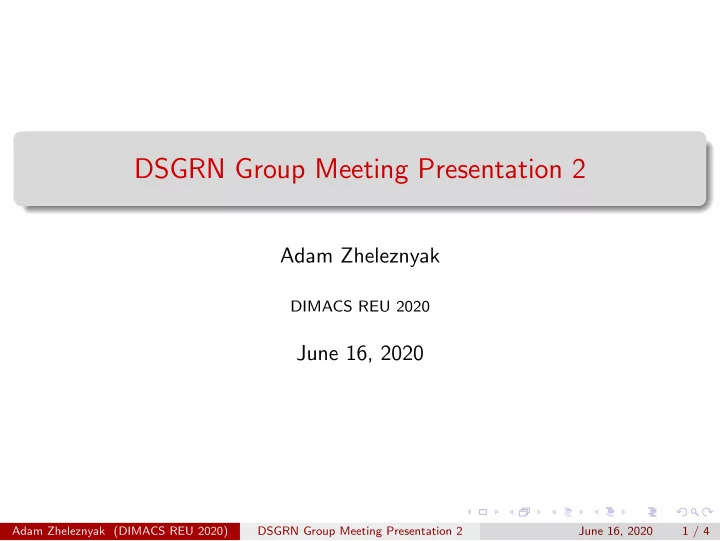

DSGRN Group Meeting Presentation 2 Adam Zheleznyak DIMACS REU 2020 June 16, 2020 Adam Zheleznyak (DIMACS REU 2020) DSGRN Group Meeting Presentation 2 June 16, 2020 1 / 4
Computing linear extensions for Boolean lattices with algebraic constraints I’ve been going through the recently submitted paper: “Computing linear extensions for Boolean lattices with algebraic constraints” (Shane Kepley, Konstantin Mischaikow, Lun Zhang) In the paper, algorithms are given that can solve this problem: Given a set of linear polynomials { p 0 , . . . , p K } , an evaluation domain Ξ that is a polytope, and a partial order ≺ such that p ≺ q when p ( ξ ) < q ( ξ ) for all ξ ∈ Ξ , then what are all the total orders p σ (1) ≺ σ · · · ≺ σ p σ ( K ) that are a linear extension to ≺ such that there is some ξ ∈ Ξ where p σ (1) ( ξ ) < · · · < p σ ( K ) ( ξ )? Adam Zheleznyak (DIMACS REU 2020) DSGRN Group Meeting Presentation 2 June 16, 2020 2 / 4
Parameter Space Decomposition Problem Given an interaction function: Say that each z i can either evaluate to ℓ i or ℓ i + δ i . This gives 2 n polynomials of the variables ℓ 1 , . . . ℓ n , δ 1 , . . . , δ n > 0. Which total orders are admissible : there is some set of values for our variables that such that these polynomials respect that order. We can use the algorithms as mentioned in the previous slide to get a stricter set of candidates of the admissible linear orders when we look at interaction functions. With some other techniques, this set can be made even stricter. Adam Zheleznyak (DIMACS REU 2020) DSGRN Group Meeting Presentation 2 June 16, 2020 3 / 4
Consequences to DSGRN This gives a major computational improvement: Before (2016): DSGRN can handle regulatory networks with nodes that have at most three in-edges and three out-edges. Now: DSGRN can handle regulatory networks with nodes that have at most five in-edges (and for some cases of six) and any number of out-edges. My Goal: To see how well these results can be generalized to handle more values i.e. instead of z evaluating to either ℓ or ℓ + δ , what about ℓ , ℓ + δ 1 , or ℓ + δ 1 + δ 2 ? Or for an arbitrary number of δ ’s? Adam Zheleznyak (DIMACS REU 2020) DSGRN Group Meeting Presentation 2 June 16, 2020 4 / 4
Recommend
More recommend